Functional Workouts: How to Plan an Effective Exercise Routine
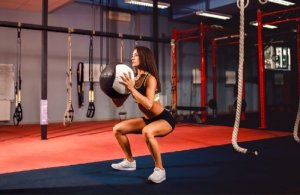
Of all the various styles of exercise that have come into vogue in recent years, functional workouts are among the most popular. The exercises that make up this discipline adapt to the specific needs of each individual. In this article, we’ll explain the best way to plan a functional workout routine.
The goal is to improve the quality of life of “regular’ people. In other words, people who don’t practice sport at a professional level. To this end, the discipline aims to improve mobility by using the body’s own weight and focusing on the kinds of movements we make in our daily lives.
Functional workouts feature exercises that require us to lift objects, jump certain lengths, and move heavy items. These are just some of the principles behind a functional regimen.
Planning functional workouts
Rather than working out specific muscles through set exercises, this discipline uses movement to exert the entire body. A basic functional workout routine usually consists of the following exercises.
1. Burpees
This is perhaps the quintessential functional exercise. Not only does it involve movement and exerting large muscle groups simultaneously, it’s also a great way of doing cardio.
It’s simple, too. Start by standing in a comfortable position. Then, tilt towards the ground and kick your legs out behind you, supporting your weight with your hands at chest-height.
After touching the ground with your chest, push yourself back up with your hands and feet, the latter of which should get as close to your hips as possible, in one explosive movement. If you do this last step falling with your legs open, it will be easier for you to get back up with stability.
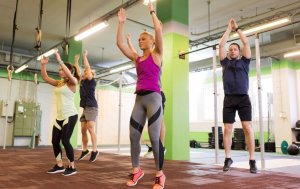
2. Deadlifts
This is a great exercise for learning how to lift heavy loads. You can do it using a sandbag, a medicine ball, a dumbbell, or a bar–with our without weights.
The idea is to lift with your knees, and not with your back. To this end, place your chosen accessory on the floor between your legs and and bend your knees to pick it up. sticking out your chest and facing forward. Then, extend your legs in order to return to your initial position.
3. BOSU ball
The BOSU ball is a fundamental part of improving your balance. We can use it in a variety of ways. One is to sit on the flat end of the ball, with the spherical end serving as the base. Once you’ve done this, stretch out your feet and extend your hands to your sides. Maintaining your balance in this position, will require a lot of effort in your abdomen.
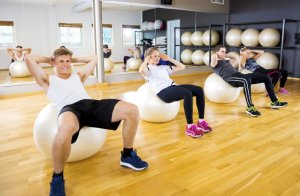
You can also use both sides of the BOSU to work your legs. The exercise consists of standing and maintaining your position, using one or both legs. You can also use it for sit-ups, small jumps, and lunges. There are many different options.
4. Pull-ups
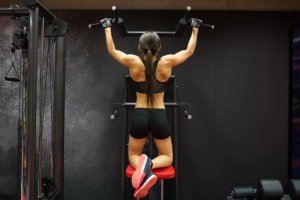
Pull-ups help to work out the arms and the entire upper body. You can start out using a bench or a box for support and go from there. You can also propel yourself with a little hop.
It’s important to adapt this exercise to your particular needs. The benefits are immense, given that it’s the most demanding exercise that uses your body’s weight.
5. Jumping jacks
Back to aerobic exercise. Jumping jacks are one of the first exercises we learn at school. It’s perfect for improving aerobic and muscular endurance, while activating the majority of the body’s muscles.
6. Push-ups
There’s no better way to work the pectoral muscles than with some classic push-ups. This functional workout technique includes a variant for beginners: place your knees on the ground with your chest on the floor. Advanced techniques include, clapping your hands over your head after each repetition.
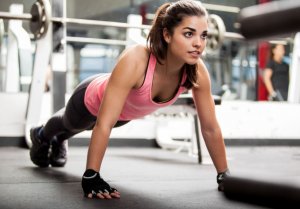
Finally, let’s add a few more exercises to the list:
– Planks and hollow sit-ups
– Superman exercises
– Traditional and sumo squats
– Trots and sprints
– Mountain climbers
As it’s not possible for most of us to run through the forest, across rivers and scale mountains – at least not every day, functional workouts provide a worthy alternative. It’s a natural, practical and highly effective way to improve your physical ability and performance.
Of all the various styles of exercise that have come into vogue in recent years, functional workouts are among the most popular. The exercises that make up this discipline adapt to the specific needs of each individual. In this article, we’ll explain the best way to plan a functional workout routine.
The goal is to improve the quality of life of “regular’ people. In other words, people who don’t practice sport at a professional level. To this end, the discipline aims to improve mobility by using the body’s own weight and focusing on the kinds of movements we make in our daily lives.
Functional workouts feature exercises that require us to lift objects, jump certain lengths, and move heavy items. These are just some of the principles behind a functional regimen.
Planning functional workouts
Rather than working out specific muscles through set exercises, this discipline uses movement to exert the entire body. A basic functional workout routine usually consists of the following exercises.
1. Burpees
This is perhaps the quintessential functional exercise. Not only does it involve movement and exerting large muscle groups simultaneously, it’s also a great way of doing cardio.
It’s simple, too. Start by standing in a comfortable position. Then, tilt towards the ground and kick your legs out behind you, supporting your weight with your hands at chest-height.
After touching the ground with your chest, push yourself back up with your hands and feet, the latter of which should get as close to your hips as possible, in one explosive movement. If you do this last step falling with your legs open, it will be easier for you to get back up with stability.

2. Deadlifts
This is a great exercise for learning how to lift heavy loads. You can do it using a sandbag, a medicine ball, a dumbbell, or a bar–with our without weights.
The idea is to lift with your knees, and not with your back. To this end, place your chosen accessory on the floor between your legs and and bend your knees to pick it up. sticking out your chest and facing forward. Then, extend your legs in order to return to your initial position.
3. BOSU ball
The BOSU ball is a fundamental part of improving your balance. We can use it in a variety of ways. One is to sit on the flat end of the ball, with the spherical end serving as the base. Once you’ve done this, stretch out your feet and extend your hands to your sides. Maintaining your balance in this position, will require a lot of effort in your abdomen.

You can also use both sides of the BOSU to work your legs. The exercise consists of standing and maintaining your position, using one or both legs. You can also use it for sit-ups, small jumps, and lunges. There are many different options.
4. Pull-ups

Pull-ups help to work out the arms and the entire upper body. You can start out using a bench or a box for support and go from there. You can also propel yourself with a little hop.
It’s important to adapt this exercise to your particular needs. The benefits are immense, given that it’s the most demanding exercise that uses your body’s weight.
5. Jumping jacks
Back to aerobic exercise. Jumping jacks are one of the first exercises we learn at school. It’s perfect for improving aerobic and muscular endurance, while activating the majority of the body’s muscles.
6. Push-ups
There’s no better way to work the pectoral muscles than with some classic push-ups. This functional workout technique includes a variant for beginners: place your knees on the ground with your chest on the floor. Advanced techniques include, clapping your hands over your head after each repetition.

Finally, let’s add a few more exercises to the list:
– Planks and hollow sit-ups
– Superman exercises
– Traditional and sumo squats
– Trots and sprints
– Mountain climbers
As it’s not possible for most of us to run through the forest, across rivers and scale mountains – at least not every day, functional workouts provide a worthy alternative. It’s a natural, practical and highly effective way to improve your physical ability and performance.
This text is provided for informational purposes only and does not replace consultation with a professional. If in doubt, consult your specialist.








